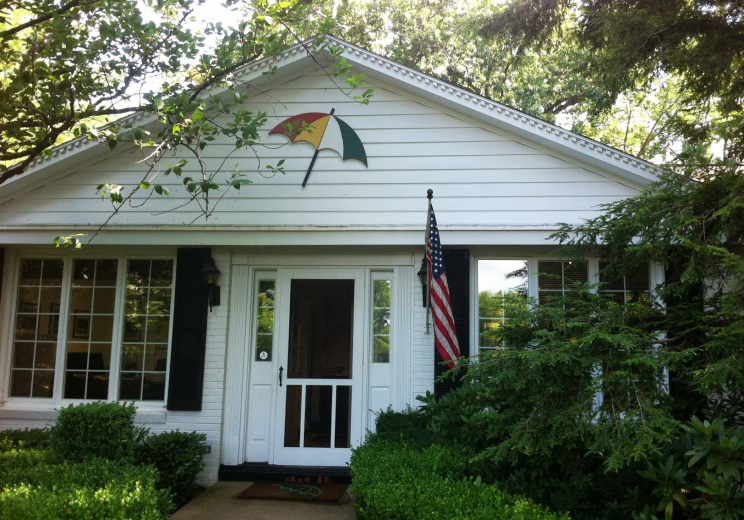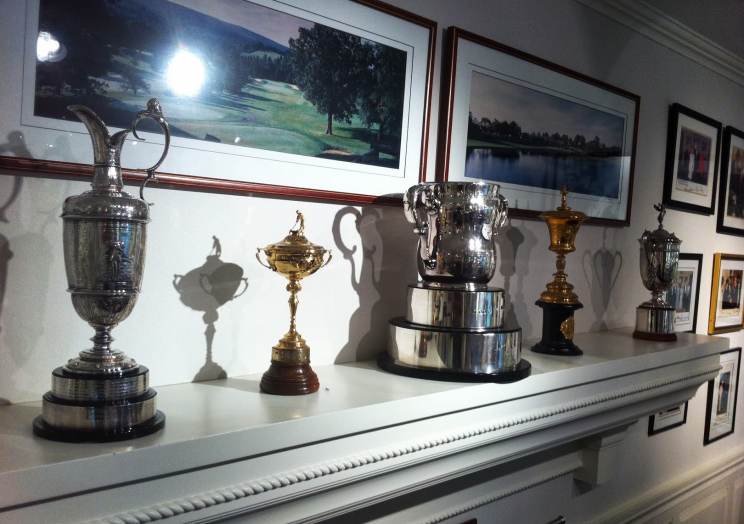On the green, on the TV, in the air, Arnold Palmer had no equal
Arnold Palmer once invited me to his hometown, and when you get that kind of invitation, you clear your schedule.
On this dark day, here’s my personal Arnold Palmer recollection.
Three years ago, I had the opportunity to spend some time with Palmer in Latrobe, a small town tucked in the hills of western Pennsylvania. Palmer’s Latrobe office is an inconspicuous white-paneled ranch home at the end of a cul-de-sac, across the street from Latrobe Country Club; the only sign that this home is different from those around it is the multicolored umbrella logo above the front door. Well, that, and the fact that you get here via a street named for the man within.
You open the screen door — much of the year around here, it’s pleasant enough to leave the front door open to the air — and there’s a receptionist’s desk and a small refrigerator full of — what else? — chilled, canned Arnold Palmers. And then you’re escorted back to his office, and … whoa.
Imagine the most impressive award you’ve ever won. Imagine the most impressive award anyone you know has ever won. Now imagine dozens of awards like that one, lining every square inch of available wall, so many that there’s not enough space for them all, so they’re stacked up two and three deep on the floor. Framed American flags, medals, scorecards, keys to cities, honorary degrees, photos of black-and-white foursomes from long-ago rounds, honors from innumerable towns and universities and companies … all here, all given with love and respect to the genial old man who, until Sunday, sat behind the enormous desk at the far side of the room.

I had an hour to speak with Arnold Palmer, and 15 minutes into our conversation, I realized I was on the verge of exhausting all of my pre-prepared questions. And that’s for a simple reason: I was asking him questions he’d been asked a thousand times before, questions about how he’d handled the transformation from groundskeeper’s boy to television idol, how he’d opened up the British Open to American players, what he thought of Tiger Woods’ chances to catch Jack Nicklaus’s majors record. (This was 2013, remember.)
Palmer had answered these questions so many times, it was like driving-range practice. So for the rest of the interview, I put the questions down, and we just talked. Talked about how he’d inspired a nation of young golfers, my dad among them. Talked about how much he loved solo flying. Talked about how he didn’t golf much anymore because the body couldn’t do what the mind remembered it could.
And somewhere along the way, a strange thing happened. I stopped thinking about how I was talking to ARNOLD PALMER, AMERICAN LEGEND and just enjoyed the astonishing stories of a guy named Arnie.
Our hour wound to a close, I asked if I could take a photo of him at his desk, and he motioned me to come stand beside him. It wasn’t what I was expecting — taking fan photos with your interview subjects isn’t exactly high on the list of ethical journalist moves — but in that moment, I figured, what the hell … it’s Arnold Palmer. And as I left Palmer’s inner sanctum, there by the front door stood Pirates pitcher Gerrit Cole, waiting with his family for an audience with Palmer, looking every bit as thrilled and nervous as I probably had been.
After the interview, Doc Giffin, Arnold’s right-hand man, the former sportswriter who’d become Palmer’s public voice, guided me around the rest of the house. And that’s where the magnitude of the man in the back office sank in, to the bone.

The house is arranged like a museum, and one day it surely will be. One wing is dedicated to Palmer’s longtime connections with presidents; you can see the Congressional Medal of Honor there, along with a set of clubs Dwight Eisenhower gifted to Palmer. (Given Eisenhower’s wayward tendencies off the tee, he was probably glad to be rid of them.) A highlight: a framed letter from Ike to Palmer, a $10 bill enclosed — payment for a bet the President made that Palmer would win the U.S. Open in 1965. He didn’t. “Enclosed is payment for my bet,” Eisenhower wrote, “and never was one more reluctantly paid.”
Other stops on the office tour included a section dedicated to Palmer’s love of flying, including a plaque honoring his world-record time circumnavigating the entire globe: 57 hours, 25 minutes, 42 seconds. (You didn’t know he held that record, did you? What would be the greatest achievement in most other men’s lives was a line on his resume.)

Palmer was a man’s man, and he had a workshop to match. Thousands of clubs stacked in bins, each one priceless, each one waiting to be worked over by Palmer’s own hand. All along the walls, again: memorabilia stacked thick. Autographed helmets, footballs and jerseys right next to cans of WD-40 and rolls of masking tape. A handmade sign that read, “Dr. Arnold D. Palmer, Esquire. Doctor of Laws. Makes Em and Breaks Em. Handles Anything. No House Calls.” You get the idea that this room was the one where Palmer was the most comfortable, a place where he could work with his hands, where he wasn’t surrounded on all sides by framed memories, where his clubs weren’t sealed behind glass.
You want a man that embodied the American Dream? Look no farther than this room. Palmer was the son of a groundskeeper who would one day buy the very club where his father once worked. He was a plainspoken kid from western Pennsylvania who would go on to become a confidant of presidents. He turned a piecemeal golf swing into a bridge between continents. Every golfer who cashes a huge check, every athlete who pitches a product, every sports fan who kicks back on a Sunday afternoon to watch games on TV — to say nothing of every person who’s ever drank deep of a tall glass of iced tea and lemonade — owes Arnold Palmer a debt we could never repay.
__________
The last time I saw Arnold swing a club was, to the best of my knowledge, the last time he ever hit a shot in public.
On a foggy April morning in 2015, Palmer, alongside fellow legends Jack Nicklaus and Gary Player, launched a ceremonial tee shot to begin that year’s Masters. Palmer’s shot hooked hard, trickling up to the edge of the nearby ninth green. But distance wasn’t the point here; Palmer had long ago covered every important stretch of fairway in the world of golf.
No, the point of this morning was to spend a few more minutes with Mr. Palmer, to watch him take one more cut in the shadow of the Augusta National clubhouse. It’s why the gallery lined 10-deep, why pros like Bubba Watson and Rickie Fowler came to the first tee hours before their Thursday tee times, all to watch Palmer swing. As long as he was here, and we were here, everything was as it should be in the world.
Palmer’s death is yet another gut-punch in this brutal year. The next time — every time — Nicklaus and Player appear in public together, Palmer’s absence will be palpable, wrenching. There’s no way around that. But raise a glass — of whatever you wish — to the golfer, the humanitarian, the rogue, the American, the guy who made the world a cooler place just by being in it.
Podcast: Remembering Arnold Palmer
Subscribe to Grandstanding • iTunes • Stitcher • Soundcloud
____
Jay Busbee is a writer for Yahoo Sports. Contact him at jay.busbee@yahoo.com or find him on Twitter or on Facebook.

 Yahoo Sports
Yahoo Sports 
